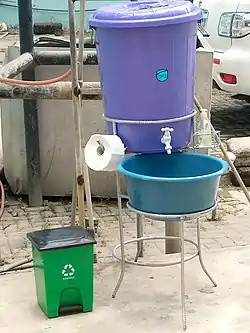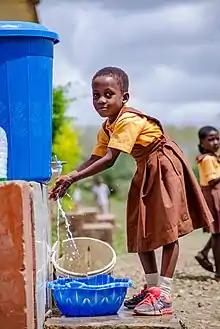Veronica bucket
The Veronica bucket[1] is a mechanism for hand washing originating in Ghana which consists of a bucket of water with a tap fixed at the bottom, mounted at hand height, and a bowl at the bottom to collect waste water. The Veronica bucket was developed by Veronica Bekoe. The Veronica bucket serves as a simple way to encourage proper hand washing using flowing water. Bekoe in an interview stated that the bucket was originally made to help her and her colleagues wash their hands under running water after each lab session. She said, "We are used to washing hands in a bowl with others washing in the same water, which will do more harm than good." These colleagues were contaminating their hands rather than decontaminating them. In addition to the COVID benefit of hand washing, the Veronica bucket is also essential for areas where potable water is not readily available.[2]
 | |
| Type | Bucket |
|---|---|
| Inventor | Veronica Bekoe |
| Available | Available |

Uses
The bucket is also used in other African countries. It is common in places such as schools, hospitals, churches and in areas with no running taps.[2] It has become very popular in Ghana following the outbreak of the novel coronavirus (COVID-19) as citizens engage in frequent hand washing to stem its spread.[3][4] In Ekiti State, Nigeria, the governor Kayode Fayemi directed all public places to provide running tap water or Veronica buckets "to encourage frequent handwashing" as part of the measures to contain COVID-19.[5]
Before the COVID-19 outbreak, the invention was used in some schools and hospitals but it is in high demand due to its role in curbing the outbreak. Now, the set up could be spotted in places like the malls, hospitals, corporate institutions and government offices. It was invented by a Ghanaian, Veronica Bekoe,[6] whom the invention was named after. She claimed the bucket was named after her in 1993 by Joan Hetrick.[7] Bekoe is a biologist who has worked at the Public Health and Reference Laboratory of the Ghana Health Service from 1972 to 2008.[8]
Production
The invention was initially produced by local artisans with aluminium utensils used in selling Hausa koko attached with a tap which was a prototype, popularly known as Akorlaa gyae su and currently it made of plastic with a tap attached to it which has an area for holding soap and towels. Variations available today comes in all colours.[9][10][11]
In February 2021, Veronica Bekoe launched an updated version of the bucket to reduce physical contact with the unit and further help halt the spread of COVID-19.[12]
See also
- WASH (water, sanitation, hygiene)
References
- "Veronica Bucket". Asembi.com. Retrieved 2020-04-19.
- "Why is this bucket called 'veronica bucket'?". Graphic.come.gh. Retrieved March 26, 2020.
- "Saving Lives with a Little Soap and Water: New Behavior Change Communication Package promotes healthy hygiene practices - Global Communities Ghana". www.globalcommunitiesgh.org. Retrieved 2020-03-26.
- "Banks in Suhum step up measures against coronavirus spread". www.msn.com. Retrieved 2020-03-27.
- Ani, Emmanual. "COVID-19: Ekiti shuts down schools, institutions". Daily Post. Retrieved 27 March 2020.
- "Who invented Veronica Bucket?". Asembi.com. Retrieved 2020-04-19.
- "Veronica Bucket inventor shares intriguing story about its origin - MyJoyOnline.com". www.myjoyonline.com. Retrieved 2021-03-19.
- "Veronica Bucket: The Ghanaian invention helping in coronavirus fight". www.ghanaweb.com. Retrieved 2020-03-26.
- "Traders cash in on Veronica buckets as demand goes up due to COVID-19". Citinewsroom. 2020-03-25. Retrieved 2020-03-26.
- "Time with Veronica Bekoe (Designer of the Veronica Bucket)".
- "How to wash your hands using Veronica Bucket - Auntie Vero teaches".
- "Veronica Bekoe launches new and improved veronica bucket". www.ghanaweb.com. 2021-02-10. Retrieved 2021-02-11.